<Back to Index>
- Commander of the 10th United States Army General Simon Bolivar Buckner, Jr., 1886
- Commandant of the Marine Corps General Alexander Archer Vandegrift, 1887
PAGE SPONSOR
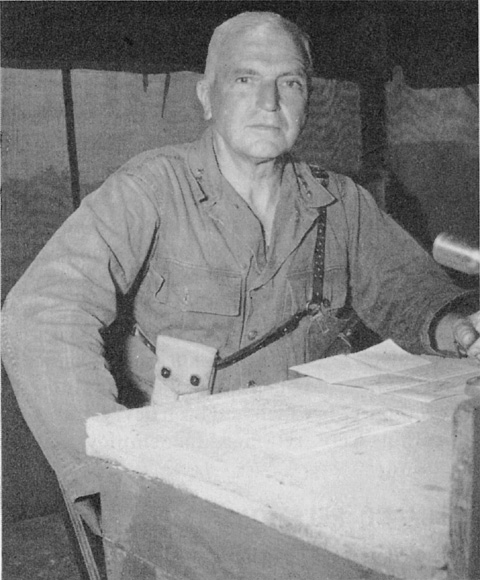
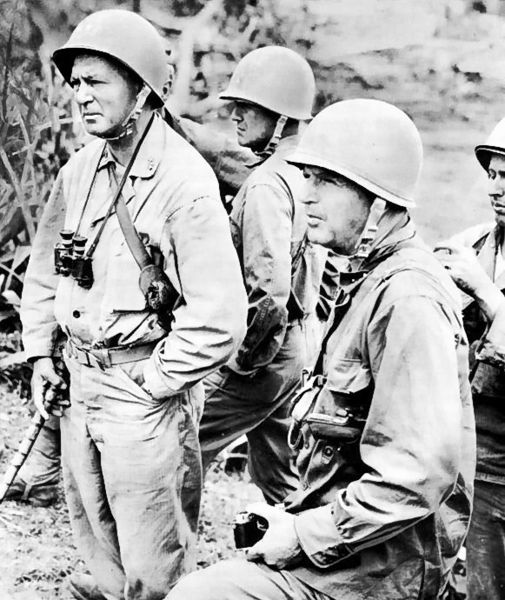
General Simon Bolivar Buckner, Jr. (July 18, 1886 – June 18, 1945) was an American lieutenant general during World War II. He served in the Pacific Theater of Operations and commanded the defenses of Alaska early in the war. After that assignment, he was promoted to command 10th Army, which conducted the amphibious assault (Operation Iceberg) on the Japanese island of Okinawa. He was killed during the closing days of the Battle of Okinawa by enemy artillery fire, making him the highest ranking U.S. military officer to have been killed by enemy fire during World War II, and among the highest ranking military officers to die during the war. Buckner was posthumously promoted to the rank of a full four star general on July 19, 1954 by a Special Act of Congress (Public Law 83-508)
His father was Confederate General Simon Bolivar Buckner, Sr., who surrendered to Ulysses S. Grant at Fort Donelson and was Governor of the Commonwealth of Kentucky 1887 - 1891.
Buckner was raised in the rural hills of western Kentucky near Munfordville, and attended Virginia Military Institute. He later won an appointment to West Point (class of 1908) from President Theodore Roosevelt. He served two tours of duty in the Philippines. During World War I, he served as a temporary major, drilling discipline into budding aviators.
Between the wars, Buckner returned to West Point as an instructor (1919 – 1923) and again as instructor and Commandant of Cadets (1932 – 1936). Though recognized as tough and fair, his insistence on developing cadets past conventional limits caused one parent to quip, "Buckner forgets that cadets are born, not quarried." He was also an instructor at the General Service Schools at Fort Leavenworth, Kansas, and was executive officer at the Army War College in Washington, D.C.
Prior to Pearl Harbor, Buckner was promoted to Brigadier General and assigned to fortify and protect Alaska as commander of the Army's Alaska Defense Command. Though comparatively quiet, there was some action with the attack on Dutch Harbor (3–5 June 1942), the Japanese seizure of the islands Kiska and Attu (June 1942), Battle of Attu (Operation Landcrab, May 1943), and "invasion" of Kiska (August, 1943).
In July 1944, Buckner was sent to Hawaii to organize the 10th Army, which was composed of both Army and Marine units. The original mission of the 10th Army was to prepare for the invasion of Taiwan; however, this operation was canceled, and Buckner's command was instead ordered to prepare for the Battle of Okinawa. This turned out to be the largest, slowest, and bloodiest sea - land - air battle in American military history. According to an eyewitness account, on June 18, 1945, Buckner had arrived in his command jeep which was flying its standard 3 star flag, to inspect a forward observation post. Visits from the general were not always welcome as his presence frequently drew enemy fire, which fortunately, usually happened as General Buckner was departing. However, on the 18th Buckner had arrived with his standard bright three stars showing on his steel helmet and a nearby Marine outpost sent a signal to Buckner's position stating that they could clearly see the general's three stars on his helmet. Told of this Buckner replaced his own helmet with an unmarked one. However, the Imperial Japanese Army artillery (Type 96 15 cm Howitzer) position had already observed General Buckner and commenced fire upon his position and exploding shrapnel tore into his chest. Buckner was carried by stretcher to a nearby aid station where he died on the operating table. Colonel Clarence R. Wallace and PFC Harry M. Sarkisian were at his side when he died. He was succeeded in command by Marine General Roy Geiger. Total American deaths during the battle of Okinawa were 12,513.
Buckner is interred in the family plot at Frankfort Cemetery in Frankfort, Kentucky.
Named in honor of Buckner:
- Fort Buckner, an Army sub-post of the Marine Corps' Camp Foster on Okinawa, is home to the 58th Signal Battalion and includes a small memorial to its namesake.
- Nakagusuku Bay on the East side of Okinawa was briefly nicknamed "Buckner Bay" in the 1940s.
- West Point's Camp Buckner, where yearlings (incoming sophomores) go through Cadet Field Training (CFT).
- Several places built in Alaska during Cold War - related military construction, including:
- Buckner Gymnasium (also Fieldhouse and Physical Fitness Center) at Fort Richardson (now part of Joint Base Elmendorf - Richardson) in Anchorage, Alaska, a post which the general established during World War II.
- The Buckner Building in Whittier, Alaska, once the largest building in Alaska by square footage.
- Buckner Drive in the Nunaka Valley subdivision of Anchorage, originally built as military housing.
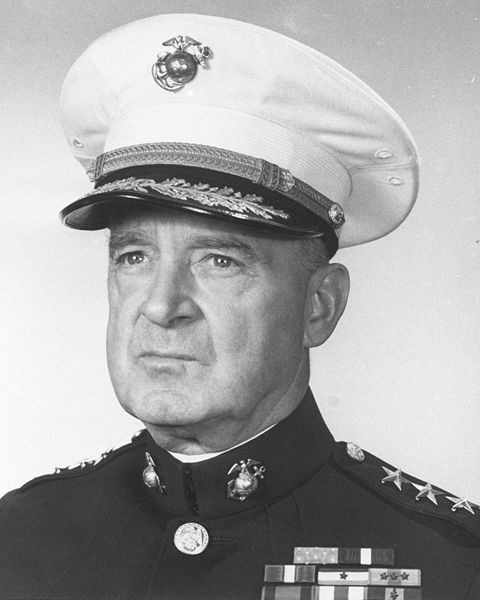
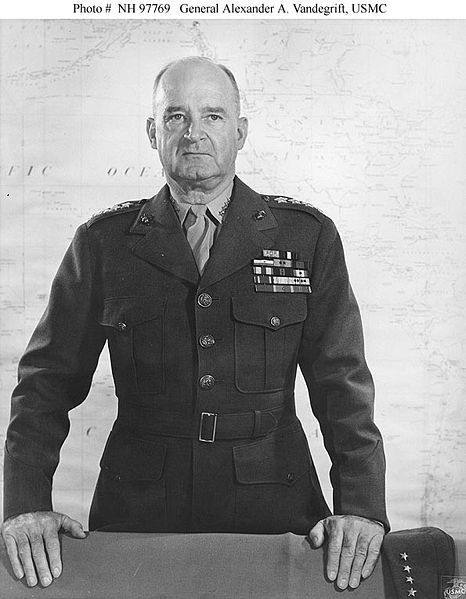
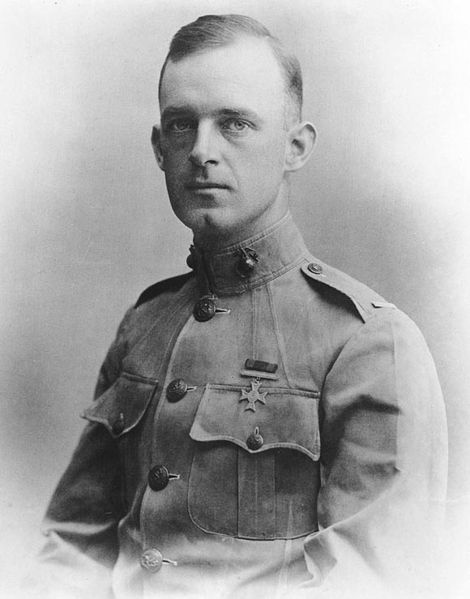
Alexander Archer Vandegrift, KBE, CB (March 13, 1887 – May 8, 1973) was a General in the United States Marine Corps. He commanded the 1st Marine Division to victory in its first ground offensive of World War II — Battle of Guadalcanal. For his actions during the Solomon Islands campaign, he received the Medal of Honor. Vandegrift later served as the 18th Commandant of the Marine Corps; and was the first U.S. Marine to hold the rank of four star general while on active duty.
Alexander Archer Vandegrift was born on March 13, 1887 in the small town of Charlottesville, Virginia, where his father was an architect and contractor. Young Vandegrift, known as "Archer" in his boyhood, had an interest in the military — both from reading military history novels and from stories of ancestors who fought in various wars.
He attended the University of Virginia for three years; then won his commission in the U.S. Marine Corps through a week long competitive examination in 1908, becoming a second lieutenant on January 22, 1909.
While at the Marine Corps Schools in 1909 he wrote a prophetic article entitled "Aviation, the Cavalry of the Future". Later as Commandant, he would appoint the Hogenboom Board that began the USMC's development of vertical envelopment, the use of helicopters for air assault. During his early years as a Second Lieutenant, General Vandegrift was also very nearly dismissed from the Marine Corps due to disciplinary infractions and negative evaluations. In his first evaluation from the Marine Corps, dated June 30, 1909, Vandegrift received an overall rating of "Not Good" with these remarks from the Commander of the Marine Officers School.
- "This officer has not shown that he appreciates the responsibilities of his position as an officer, and unless there is a decisive improvement, his relations will not be to the advantage of the service."
In
Vandegrift's next evaluation, dated December 1909, he received a "Good
and Tolerable" rating and next was rated as "Excellent" upon reporting to the Marine Corps Barracks, Navy Yard, Portsmouth, New Hampshire in 1910.
Following instruction at the Marine Officers' School, Port Royal, South Carolina, his first tour of duty was at the Marine Barracks, Portsmouth, New Hampshire. In 1912, he went to foreign shore duty in the Caribbean, first to Cuba and then to Nicaragua. He participated in the bombardment, assault, and capture of Coyotepe in Nicaragua. Then in 1914, he participated in the engagement and occupation of Vera Cruz, Mexico.
In December 1914, following his promotion to first lieutenant, he attended the Advance Base Course at the Marine Barracks, Philadelphia. Upon completion of schooling, he sailed for Haiti with the 1st Marines and participated in action against hostile Cacos bandits at Le Trou and Fort Capois, Haiti.
In August 1916, he was promoted to captain and became a member of the Haitian Constabulary at Port - au - Prince,
where he remained until detached to the United States in December 1918.
He returned to Haiti again in July 1919 to serve with the Gendarmerie d'Haiti as an Inspector of Constabulary. He was promoted to major in June 1920.
Major Vandegrift returned to the U.S. in April 1923 and was assigned to the Marine Barracks, MCB Quantico, Virginia. He completed the Field Officers' Course, Marine Corps Schools, in May 1926. He then was transferred to the Marine Corps Base San Diego, California, as Assistant Chief of Staff.
In February 1927, he sailed for China where he served as Operations and Training Officer of the 3rd Marines with Headquarters at Tientsin. He was ordered to Washington, D.C., in September 1928 where he became Assistant Chief Coordinator, Bureau of the Budget.
Following duty in Washington, D.C., he joined the Marine Barracks, Quantico, where he became Assistant Chief of Staff, G-1 Section, Fleet Marine Force (FMF). During this assignment, in June 1934, he was promoted to lieutenant colonel.
Ordered
to China in June 1935, LtCol Vandegrift served successively as
Executive Officer and Commanding Officer of the Marine Detachment at the
American Embassy in Peiping. Promoted to colonel in September 1936, Col Vandegrift reported to Headquarters Marine Corps (HQMC), Washington, D.C., in June 1937, where he became Military Secretary to the Major General Commandant. In March 1940, he was appointed Assistant to the Major General Commandant, and the following month was promoted to brigadier general.
Brigadier General Vandegrift was detached to the 1st Marine Division in November 1941, shortly before the United States of America entered World War II. He was promoted to major general in March 1942 and sailed for the South Pacific Area that May as commanding general of the first Marine division to ever leave the shores of the United States. On August 7, 1942, in the Solomon Islands, he led ashore the 1st Marine Division in the first large scale offensive action against the Japanese, which was the first ground offensive of World War II. For outstanding service as Commanding General of the 1st Marine Division during the attack on Guadalcanal, Tulagi, and Gavutu in the Solomon Islands, he was awarded the Navy Cross and for the subsequent occupation and defense from August 7 to December 9, 1942, received the Medal of Honor.
In July 1943, he assumed command of the 1st Marine Amphibious Corps and commanded this organization in the landing at Empress Augusta Bay, Bougainville,
Northern Solomon Islands, on November 1, 1943. Upon establishing the
initial beachhead, he relinquished command and returned to Washington,
D.C. as Commandant designate.
On January 1, 1944, as a lieutenant general, he was sworn in as the 18th Commandant of the Marine Corps. On April 4, 1945, he was appointed general, with date of rank from March 21, 1945, the first Marine officer on active duty to attain four star rank.
During his tenure as Commandant, the Marine Corps faced institutional threats from Army efforts to absorb the mission of the Marines. Though the Navy was sympathetic to the Marine Corps' predicament, it was ready to accept the diminishment of the Corps in exchange for keeping naval aviation from consolidation within the Air Force. The post war discussions on the restructuring of the American defense establishment opened the door to diminishing the mission and role of the Marine Corps in the new defense structure. Proponents of such cuts included President Harry Truman and General Dwight Eisenhower. In this power struggle, the Marine Corps aligned itself with Congress, warning against the encroachment on civilian oversight within the Army proposals.
To cinch the support of Congress, Commandant Vandegrift delivered the famous "bended knee speech" on May 6, 1946 to the Senate Committee on Naval Affairs. In it, he stated
The Marine Corps... believes that it has earned this right — to have its future decided by the legislative body which created it — nothing more. Sentiment is not a valid consideration in determining questions of national security. We have pride in ourselves and in our past, but we do not rest our case on any presumed ground of gratitude owing us from the Nation. The bended knee is not a tradition of our Corps. If the Marine as a fighting man has not made a case for himself after 170 years of service, he must go. But I think you will agree with me that he has earned the right to depart with dignity and honor, not by subjugation to the status of uselessness and servility planned for him by the War Department.
For outstanding service as Commandant of the Marine Corps from January 1, 1944 to June 30, 1946, General Vandegrift was awarded the Distinguished Service Medal. He left active service on December 31, 1947 and was placed on the retired list on April 1, 1949.
The general co-authored a book chronicling his experiences in World War II. The book is titled Once a Marine: The Memoirs of General A. A. Vandegrift Commandant of the U.S. Marines in WW II.
General Vandegrift died on May 8, 1973, at the National Naval Medical Center, Bethesda, Maryland, after a long illness. His interment was on May 10, 1973 at the Arlington National Cemetery.
The President of the United States takes pleasure in presenting the MEDAL OF HONOR to
MAJOR GENERAL ALEXANDER VANDEGRIFT
UNITED STATES MARINE CORPS
for service as set forth in the following CITATION:
- For outstanding and heroic accomplishment above and beyond the call of duty as commanding officer of the 1st Marine Division in operations against enemy Japanese forces in the Solomon Islands during the period August 7, to December 9, 1942. With the adverse factors of weather, terrain, and disease making his task a difficult and hazardous undertaking, and with his command eventually including sea, land, and air forces of Army, Navy and Marine Corps, Major General Vandegrift achieved marked success in commanding the initial landings of the United States forces in the Solomon Islands and in their subsequent occupation. His tenacity, courage, and resourcefulness prevailed against a strong, determined, and experienced enemy, and the gallant fighting spirit of the men under his inspiring leadership enabled them to withstand aerial, land, and sea bombardment, to surmount all obstacles, and leave a disorganized and ravaged enemy. This dangerous but vital mission, accomplished at the constant risk of his life, resulted in securing a valuable base for further operations of our forces against the enemy, and its successful completion reflects great credit upon Major General Vandegrift, his command, and the United States Naval Service.
/S/ FRANKLIN D. ROOSEVELT
General Vandegrift held an honorary degree of Doctor of Military Science from Pennsylvania Military College, and honorary degrees of Doctor of Law from Harvard, Colgate, Brown, Columbia, and Maryland Universities and John Marshall College.
In 1982, the frigate, USS Vandegrift (FFG-48) was named in his honor.
The main street that runs through Camp Pendleton is named Vandegrift Blvd in his honor.
A former military housing complex, now civilian housing, for Wright - Patterson Air Force Base, near Dayton, Ohio, has streets named for World War II commanders including Gen Vandegrift, Gen Eisenhower, Adm Nimitz and others.
Vandegrift married Mildred Strode (1886 – 1952) on June 29, 1909. They had one son, Alexander Archer Vandegrift, Jr. (1911 – 1969 ), a Marine Corps colonel who fought in both World War II and in the Korean War. He married after Mildred's death — to Kathryn Henson (1903 – 1978).